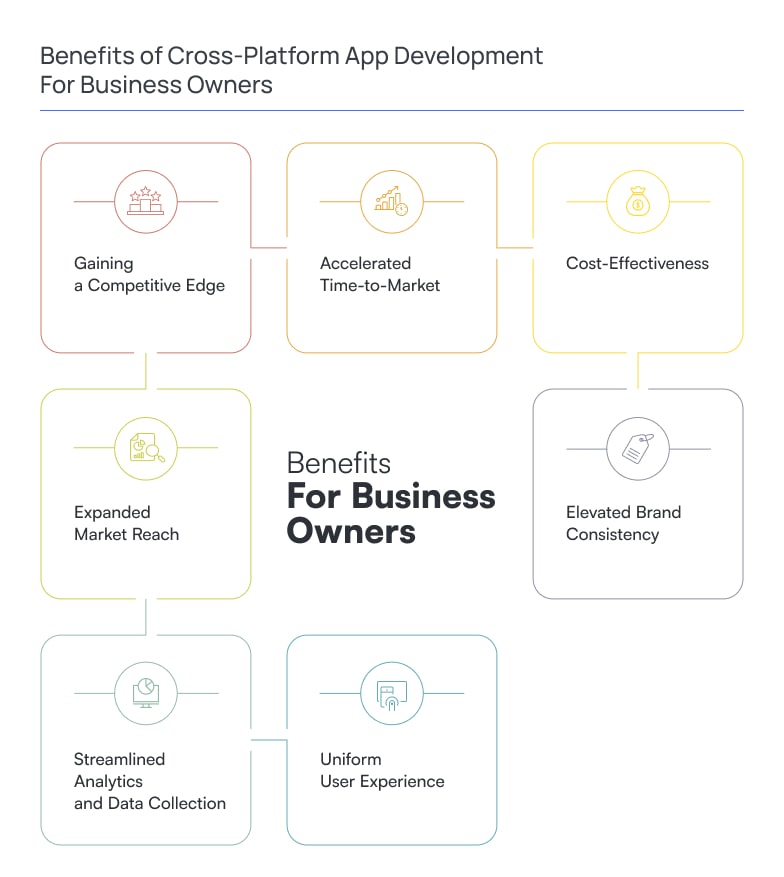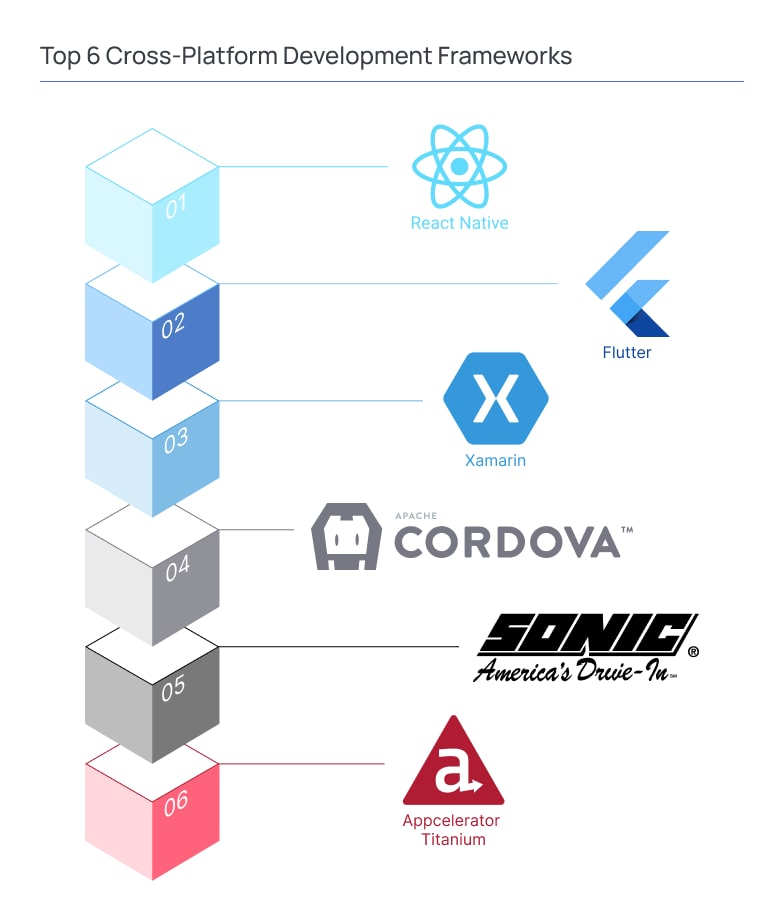Do you use mobile apps? Well, we think this question is rhetorical. Mobile applications have become the lifeblood of businesses and individuals alike. Whether for streamlining operations, engaging users, or accessing essential services, mobile apps have transformed how we interact with technology. However, in a market dominated by both iOS and Android, building and maintaining multiple native apps can be a daunting and resource-intensive task.
Enter mobile cross-platform development – a game-changing approach that allows developers to create apps that seamlessly run on multiple operating systems using a single codebase. This approach offers a compelling solution to the challenges posed by the differences between iOS and Android.
In this comprehensive article, we will provide information that explores the advantages and disadvantages of cross-platform app development and delves into the crucial decision-making process of selecting the proper development framework. We will navigate the intricacies of this multifaceted landscape, shedding light on the key considerations that can impact the success of your mobile app project.
What is Cross-Platform Mobile Application Development?
Cross-platform mobile app development is an essential approach to crafting software for mobile devices, one of three methods in the dynamic field of mobile software development, each with its unique benefits and drawbacks:
Cross-Platform Development
This approach focuses on creating software applications seamlessly operating across diverse mobile platforms. A defining feature is using a single codebase, where a substantial portion, if not all, of the code can be shared or reused across various mobile operating systems. Specialized frameworks are crucial in facilitating this, minimizing limitations, and striving to provide a native-like user experience.
Native Development
In this method, applications are exclusively designed for a specific platform. Developers concentrate on harnessing all the software and hardware capabilities inherent to that platform. However, this exclusivity means the code cannot be repurposed for other platforms.
Hybrid Development
Hybrid development blends native and web technologies, creating a synergy between the two. Initially, the code uses web development languages like CSS or HTML. Subsequently, it is enveloped within a “native” shell. Hybrid apps share several characteristics with cross-platform applications, and the distinctions between them are sometimes subtle, leading some professionals to simplify by grouping them.
The mobile device landscape is currently dominated by two main operating systems, Android and iOS, which collectively hold more than 99% of the market share, rendering all other operating systems nearly insignificant.
Consequently, when referring to a “cross-platform mobile application” in contemporary discussions, it invariably denotes a software product tailored for compatibility with Android and iOS devices. This strategic choice ensures broad accessibility and relevance in the mobile application ecosystem.
Benefits of Cross-Platform App Development For Business Owners
Businesses often overlook the intricacies of app development, focusing more on budget planning and desired outcomes. However, understanding the development process and its advantages and challenges is vital for preparedness in an ever-competitive digital landscape.

Gaining a Competitive Edge
In the highly competitive digital realm, especially in mobile software solutions, gaining a competitive edge is imperative during growth and at the earliest stages of creativity. When you are developing mobile apps for multiple platforms, they offer a distinctive advantage by delivering a unified experience across various platforms. They ensure consistent performance and enable businesses to reach a broader audience. Leveraging this technology equips businesses with the tools to distinguish themselves from competitors and elevate their market positioning.
Accelerated Time-to-Market
Modern cross-platform development frameworks offer flexibility and simplicity, expediting the app release process. Developers can target multiple platforms simultaneously by sharing code and resources, resulting in a significantly faster time-to-market. This agility is particularly valuable in fiercely competitive industries, eliminating the need to expend resources while waiting for the app to launch.
For example, you plan to learn how to make an app like Instagram but with new, unique features. You can focus on cross-platform app development, so you won’t waste time and release your product faster.
Cost-Effectiveness
Undoubtedly, software development entails substantial expenses. However, cross-platform applications justify their costs by providing a product that functions seamlessly across different platforms. It saves resources that would otherwise be allocated to developing multiple separate applications. The cost-effectiveness of paying for one application as opposed to two is evident.
Expanded Market Reach
The primary objective of cross-platform development is to achieve a broader reach at a lower cost and with reduced effort. By targeting multiple platforms with a single app, companies can expand their market presence and tap into diverse user bases. This extended market reach opens doors to increased user acquisition and revenue generation.
Elevated Brand Consistency
Consistency in brand experience is crucial for building trust and recognition. Cross-platform development overcomes this challenge by ensuring the app maintains a uniform look, feel, and branding across all platforms. This consistent branding strengthens the brand identity and fosters a cohesive user experience throughout the customer journey.
Streamlined Analytics and Data Collection
Analytics and data collection are essential for understanding user behavior, preferences, and app performance. Cross-platform applications enable businesses to implement unified analytics solutions that gather data from all platforms. This streamlined approach simplifies data collection, analysis, and reporting, providing valuable insights for informed decision-making and future app performance optimization.
Uniform User Experience
At the heart of any product or service lies user experience and satisfaction. Delivering a consistent user experience across platforms is paramount for building brand loyalty and reputation. Cross-platform mobile applications incorporate unified UI/UX elements, guaranteeing a cohesive and seamless experience for users, regardless of their device. It means that users will enjoy the same, ideally flawless, experience with the app on different devices, even if they have varying operating systems.
We understand that your app idea is more than just a concept; it's your vision for success. Take the next step by partnering with us to bring your dream app to life.
Contact Binerals!Benefits Of Multiplatform App Development For Developers
In app development, businesses gravitate towards metrics like return on investment, revenue generation, and conversion rates. However, the development team delves into the nuanced technical aspects that power cross-platform application development.
Utilizing Code Efficiency
A pivotal advantage in multiplatform mobile app development is code reusability. Leveraging popular frameworks such as React Native, Flutter, or Xamarin, developers can craft a single codebase deployable across diverse platforms, including iOS and Android. This code reusability factor significantly slashes development timelines, minimizes effort, and ultimately reduces costs.
Harnessing Native Device Functions
Contrary to common misconceptions, modern open-source, cross-platform frameworks like React Native and Flutter offer seamless access to native device features. These frameworks provide comprehensive APIs and libraries, empowering developers to tap into device-specific functionalities such as cameras, geolocation, and push notifications while maintaining stellar application performance.
Efficient Testing Protocols
Testing constitutes a pivotal facet of app development. Robust development is accompanied by solid testing capabilities for cross-platform apps, enabling developers to compose tests once and execute them across multiple platforms. This streamlined testing process enhances quality control and speeds up debugging.
Enhanced Maintenance and Support
Managing separate apps for distinct platforms can become resource-intensive, particularly without an in-house team dedicated to ongoing maintenance. Cross-platform development simplifies maintenance and support processes, enabling businesses and development teams to address issues and update all platforms uniformly. It results in streamlined support workflows, reduced costs, and heightened customer satisfaction.
Quick Prototyping and Iteration
In the fiercely competitive app market, speed and agility are paramount. Cross-platform development facilitates swift prototyping and iteration cycles, commencing with Minimum Viable Products (MVPs). By sharing code and resources, developers can swiftly construct and test prototypes, solicit user feedback, and iterate on app features and functionalities. This iterative approach empowers businesses to adapt promptly to evolving market demands.
Simplified App Integrations
Fully functional apps often rely on third-party services, APIs, and backend system integrations. Cross-platform development simplifies the integration process, as most integrations can be implemented once and effortlessly deployed across all platforms. This feature expedites the app’s connection to services, enhancing overall app functionality and user experience.
Boosted Developer Productivity
Cross-platform development diminishes the learning curve for developers. Most frameworks employ familiar technologies and languages, facilitating rapid adaptation and productivity when crafting apps for multiple platforms. Highlighted productivity enables the development team to allocate resources more efficiently, accelerating development cycles and reducing time-to-market.
Drawbacks Of Cross-Platform Application Development
Of course, apart from benefits for developers and businesses, it is worth noting the challenges cross-platform app development has.
Performance Considerations
Cross-platform applications may not deliver the same level of performance as native apps because they rely on a shared codebase across multiple platforms.
Compatibility Challenges
Each platform has unique design guidelines, features, and functionalities, making it intricate to develop an app that seamlessly fits all platforms.
Learning Curve Complexities
Cross-platform development often necessitates acquiring new tools, technologies, and frameworks, which can be time-consuming and challenging for developers accustomed to working with native languages and tools.
Adapting to OS and Device Updates
Sustaining compatibility with evolving operating systems and devices can pose challenges for cross-platform app developers.
However, It’s important to note that while cross-platform development comes with a few challenges, these obstacles are often outweighed by its substantial benefits.
Top 6 Cross-Platform Development Frameworks
What tools do developers use to create cross-platform apps? Below, you will find the list of the most popular frameworks.

React Native
Developed by Facebook, React Native is a popular open-source framework that uses JavaScript and React to build mobile apps for iOS and Android. It offers a rich ecosystem of libraries and plugins and is known for its performance and developer-friendly features. At Binerals, we use React Native to build cross-platform mobile apps since it contains all the necessary tools to implement a top-notch app.
For instance, you might have ideas to create a dating app, and we will help you turn your ideas into reality faster since we will build the app directly for two platforms. And, by the way, you can read how to make a dating app properly.
Flutter
Flutter is Google’s UI toolkit for building natively compiled mobile, web, and desktop applications from a single codebase. It uses the Dart programming language and is known for its fast development and expressive, flexible UI.
Xamarin
Owned by Microsoft, Xamarin allows developers to use C# and .NET to build native-like apps for iOS, Android, macOS, and watchOS. It offers a wide range of tools and libraries, and developers can share a significant portion of their code.
Apache Cordova
Apache Cordova, primarily targeting mobile platforms like Android, iOS, and Windows Phone, is a framework that combines CSS, HTML, and JavaScript. Its predecessor, PhoneGap, had a broader scope, supporting various phones and operating systems, including Blackberry, Nokia Symbian OS, Tizen, and more. Apache Cordova harnesses the power of native WebView to leverage device capabilities.
Ionic
Ionic is an open-source framework that combines HTML, CSS, and JavaScript to create mobile and web apps. It uses a single codebase and offers a rich set of pre-designed UI components for building cross-platform applications.
Appcelerator Titanium
Appcelerator Titanium allows developers to use JavaScript to build native iOS, Android, and Windows mobile apps. It provides access to native APIs and features a strong community and marketplace for plugins.
Crucial Tips To Consider When Choosing The Best Cross-Platform Development Framework
Finally, you should know the main tips for choosing the framework that best suits your project.
Optimizing Time Efficiency
Time efficiency is a critical aspect of framework selection. Lengthy procedures can be off-putting, as people generally prefer swift outcomes. A commendable framework should excel in implementing essential functionalities promptly, ensuring timely project delivery. Reduced development time not only accelerates time-to-market but also translates to cost savings. Therefore, it’s imperative to choose a framework that minimizes development time.
Developer-Centric Approach
When evaluating frameworks, developer-friendliness emerges as a pivotal factor to consider. The intricacy of app design directly affects time management, potentially leading to delayed development, which, in turn, hampers product availability and escalates the final project budget. Opting for a developer-friendly framework facilitates a smooth transition from concept to the final product, reducing development complexities and ensuring efficient utilization of resources.
Prioritizing Scalability
Scalability is an additional imperative. Opt for a mobile app development framework accommodating an expanding user base. As your app’s demand surges, it should seamlessly incorporate functionalities catering to a diverse range of user requests per minute (RPMs), ensuring a consistent and satisfactory user experience.
Emphasizing Speed and Performance
Speed stands out as a paramount consideration since it wields direct influence over app performance. The majority of modern applications rely heavily on speed to retain users. A swift and responsive user experience keeps users engaged and satisfied while slow-loading apps can lead to user attrition. Therefore, selecting a framework renowned for speed and efficiency is pivotal to meeting the demanding performance expectations of users.
Managing Development Costs Wisely
Managing development costs effectively is a crucial aspect of framework selection. Your chosen framework should align with your budgetary constraints. In scenarios with limited resources, it is prudent to opt for a cost-effective development framework while focusing on essential app functionalities, ensuring cost control without compromising core features.
Prioritizing Robust Security Measures
Security considerations should be at the forefront when selecting a development framework. Comprehensive security measures are vital to guard against subtle breaches and unauthorized access. Particularly in environments where Wi-Fi and mobile data pose security vulnerabilities, opting for a platform that guarantees security and speed is imperative.
For instance, isolation of the app’s payment gateway from potential risk sources and rigorous vulnerability and penetration testing should be integral to the chosen framework’s security features.
Ensuring Superior Quality Output
The quality of the final output significantly influences its success. High-quality apps attract a larger user base and enhance the overall user experience (UX), potentially attracting new clients. Conversely, poor quality can harm the app’s overall performance and user satisfaction. Therefore, selecting a framework should prioritize delivering a consistent and high-quality user experience at every touchpoint.
Wrapping Up
As we reach the conclusion of our exploration into cross-platform mobile app development, it becomes clear that this approach is not merely a trend but a transformative force that continues to reshape the industry.
From the advantages of reduced development time and costs to the potential pitfalls of performance limitations and compatibility challenges, the path to cross-platform excellence is paved with valuable insights. By understanding these benefits and drawbacks, you are well-equipped to navigate the intricacies of this innovative approach.
Crucially, the choice of a cross-platform development framework emerges as a cornerstone decision that holds the power to determine the trajectory of your mobile app project. Whether your goal is to expand your digital presence, engage a wider audience, or optimize development resources, selecting the right framework is the compass that guides your journey.
However, it’s essential to remember that the world of digital solutions extends beyond mobile apps. For instance, if you’re interested in building a website like LinkedIn, which requires a robust web platform, you’ll find valuable insights in our article on how to build a website like LinkedIn. While cross-platform apps cater to mobile devices, creating a comprehensive digital presence often involves mobile apps and a user-friendly website.
We understand that cross-platform app development may raise questions and uncertainties. Don't let these concerns hold you back. Contact our experienced team at Binerals.
ContactFAQ
What is cross-platform mobile app development?
Cross-platform mobile app development is an approach that allows developers to create mobile applications that can run on multiple operating systems (e.g., iOS and Android) using a single codebase. It streamlines development, reduces costs, and broadens the app’s reach.
What are the main benefits of cross-platform mobile app development?
For businesses, it is a competitive edge, accelerated time-to-market, cost-effectiveness, expanded market reach, elevated brand consistency, streamlined analytics and data collection, and uniform user experience.
For developers, benefits include code efficiency, harnessing native device functions, efficient testing protocols, enhanced maintenance and support, quick prototyping and iteration, simplified app integrations, and boosted developer productivity.
How do I choose the right cross-platform development framework for my project?
Consider factors such as optimizing time efficiency, developer-centric approach, prioritizing scalability, emphasizing speed and performance, managing development costs effectively, prioritizing robust security measures, and ensuring superior quality output.
